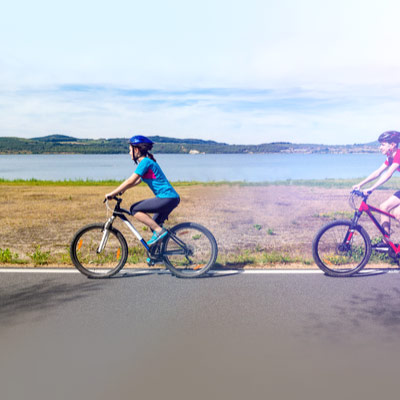 Parents may breathe a sigh of relief when their teens decide to bike somewhere instead of driving — after all, it’s healthier, it doesn’t use up gasoline, and teens probably have a lot more experience with it. You’ve probably made sure they know basic bike safety and traffic rules. But there are a few unexpected facts that can make a big difference.
Parents may breathe a sigh of relief when their teens decide to bike somewhere instead of driving — after all, it’s healthier, it doesn’t use up gasoline, and teens probably have a lot more experience with it. You’ve probably made sure they know basic bike safety and traffic rules. But there are a few unexpected facts that can make a big difference.
(Speaking of the unexpected, statistically, you’re probably more at risk cycling than your teen — the National Highway Traffic Safety Administration says: “In fact, middle-age adults represent the average age of bicycle riders killed and injured.â€)
“Wearing white has not been shown to make you more visible,†says the NHTSA. So what does? Well, lights and reflectors on the bike, obviously — they’re probably required by law in your area, anyway. But as for clothing, bright colors, including neon and fluorescent, are a more visible choice. In fact, fluorescent clothes will make cyclists more visible in daylight as well as darkness. More of us “middle-age adults†should’ve kept our fluorescent shirts from the 80’s. Oh well, there’s always reflective tape. However . . .
“Being visible is different from being noticed,†according to Dr. Sandar Tin Tin, who recently finished a study on the subject in New Zealand. “[I]t depends on drivers’ attention to and expectation of the cyclists,” she says. So what’s a cyclist to do? If possible, ride mostly on routes that are already popular for cycling — and maybe encourage others in the area to ride their bikes more often. More cyclists out there will make for more awareness in drivers.
“Riding on sidewalks does not reduce the risk of injury; in fact, the relative risk of injury when riding on sidewalks is much greater than when riding on roads,†says the U.S. Department of Transportation, citing research from the 90’s. (I’ll note that the NHTSA recommends children under 10 stick to the sidewalk, but we’re talking about teens here.) They figure it’s because there are more things and people to hit on the sidewalk, more danger from cars at intersections and driveways — and also because people who only feel safe riding on the sidewalk tend to be inexperienced cyclists. If your teen isn’t riding in the street already, it’s time they learned to.
Cycling impaired can be as dangerous as driving impaired. Twenty to 24% of cyclists killed in crashes in 2013 had high blood alcohol counts. And of course, alcohol isn’t the only thing that can impair someone. Let your teen know that it’s better to get a ride home — or even to call you.
Most bicyclist deaths happen away from intersections, says the NHTSA — but, according to the DOT, “Most [car/bike] crashes occurred when the bicyclist and motorist were on intersecting paths or when one was turning.†Confusing, but the takeaway from this is probably to be alert for turning cars, even when you’re not near an intersection, and to be extra careful when turning yourself.










